UV Fused Silica Wedged Windows

- 30 arcminute Wedge
- Eliminate Etalon Effects and Prevent Cavity Feedback
- Uncoated and AR-Coated UV Fused Silica Substrates
- Custom Options Available
WW41050
Ø1", Uncoated
WW40530-A
Ø1/2", 350 - 700 nm AR Coated
VPWW42-C
Ø1.5", 1050 - 1700 nm AR Coated
Back Reflections from Wedges Are Not Collinear with the Incident Beam
(Drawing not to Scale)
WW42012-B
Ø2", 650 - 1050 nm AR Coated

Please Wait
| Wedged Window Selection Guide | |
|---|---|
| Wavelength Range | Substrate Material |
| 180 nm - 8.0 µm | Calcium Fluoride (CaF2) |
| 185 nm - 2.1 μm | UV Fused Silica |
| 200 nm - 5.0 µm | Sapphire |
| 200 nm - 6.0 µm | Magnesium Fluoride (MgF2) |
| 200 nm - 11 µm | Barium Fluoride (BaF2) |
| 250 nm - 1.6 µm | UV Fused Silica for 45° AOI |
| 350 nm - 2.0 μm | N-BK7 |
| 600 nm - 16 µm | Zinc Selenide (ZnSe) |
| 1.2 - 8.0 µm | Silicon (Si) |
| 2.0 - 16 µm | Germanium (Ge) |
| V-Coated Wedged Windows | |
| Optical Port with Wedged Window | |
Features
- 30 arcmin Wedge
- Available Uncoated or with One of Four Broadband AR Coatings
- 245 - 400 nm (-UV Coating Designation)
- 350 - 700 nm (-A Coating Designation)
- 650 - 1050 nm (-B Coating Designation)
- 1050 - 1700 nm (-C Coating Designation)
- Available in Ø1/2", Ø1", Ø1.5", and Ø2" Sizes
- Custom Sizes Available by Contacting Tech Support
Thorlabs offers a line of wedged UV fused silica windows that eliminate fringe patterns and can be used to help avoid cavity feedback. Windows are useful for protecting a laser output from environmental effects and for beam sampling applications. We also supply parallel windows with a variety of substrate materials and AR coating options.
UV-grade fused silica is well suited for applications that benefit from increased transmission deeper into the UV than N-BK7. UV fused silica also offers a lower index of refraction for a given wavelength, better homogeneity, and a lower coefficient of thermal expansion than N-BK7. These windows are available either uncoated (185 nm - 2.1 μm) or with one of our four low-loss standard broadband antireflection (BBAR) coatings deposited on both optical surfaces. The BBAR coatings are designed for the following ranges: 245 - 400 nm (-UV), 350 - 700 nm (-A), 650 - 1050 nm (-B), or 1050 - 1700 nm (-C). While uncoated windows have typical losses of about 4% per surface, the BBAR coatings reduce this to Ravg <0.5% per surface over the specified wavelength range and provide good performance for angles of incidence between 0° and 30°. BBAR coating curve information can be found under the Graphs tab.
In addition to the UV fused silica wedged windows offered here, Thorlabs also offers wedged windows with other substrate materials (see the selection guide above and to the right). Wedged Laser Windows with AR coatings centered around common lasing wavelengths, wedged Beam Samplers with broadband AR coatings on only one face, and wedged window Optical Ports for vacuum systems are also available. Additionally, wedged windows with custom sizes and thicknesses are available; please contact Tech Support for more information.
All of these UVFS wedged windows can be ordered uncoated or with one of the following broadband AR coatings: 245 - 400 nm (designated as -UV), 350 - 700 nm (designated as -A), 650 - 1050 nm (designated as -B), or 1050 - 1700 nm (designated as -C).
Thorlabs' high-performance multilayer AR coatings have an average reflectance of less than 0.5% (per surface) across the specified wavelength ranges (denoted by the shaded blue area in the Coating graphs below). These AR coatings provide good performance for angles of incidence (AOI) between 0° and 30° (0.5 NA). The substrate transmission graph below shows the transmission of light through an uncoated UVFS substrate. For optics intended to be used at larger incident angles, consider our windows optimized for a 45° angle of incidence and recommended for use with incidence angles from 25° to 52°. Please contact Tech Support to order optics with custom coatings or sizes.
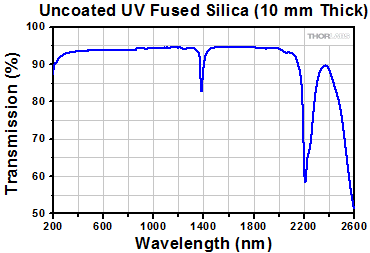
Click to Enlarge
Click Here for Raw Data
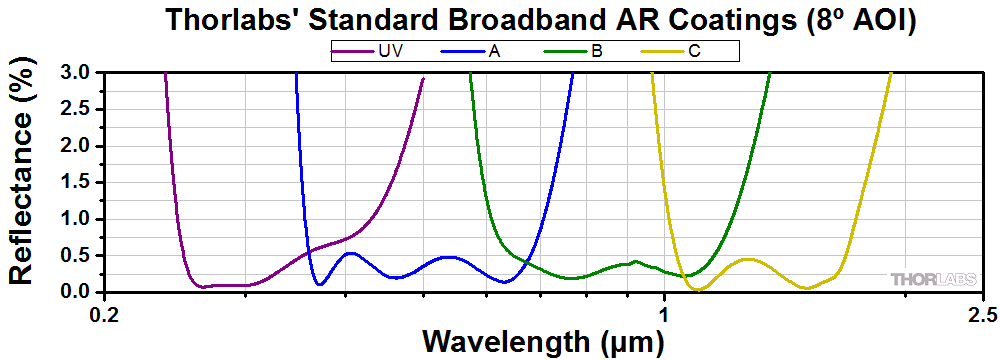
| Damage Threshold Specifications | ||
|---|---|---|
| Coating Designation (Item # Suffix) |
Damage Threshold | |
| -UV | Pulse | 5.0 J/cm2 at 355 nm, 10 ns, 10 Hz, Ø0.350 mm |
| -A | Pulse | 7.5 J/cm2 at 532 nm, 10 ns, 10 Hz, Ø0.491 mm |
| CWa,b | 550 W/cm (532 nm, Ø1.000 mm) | |
| -B | Pulse | 0.246 J/cm2 at 800 nm, 99 fs, 1 kHz, Ø0.166 mm 7.5 J/cm2 at 810 nm, 10 ns, 10 Hz, Ø0.133 mm |
| CWa,b | 20 kW/cm (1070 nm, Ø0.974 mm) | |
| -C | Pulse | 7.5 J/cm2 at 1542 nm, 10 ns, 10 Hz, Ø0.189 mm |
| CWa,b | 350 W/cm (1540 nm, Ø1.030 mm) | |
Damage Threshold Data for Thorlabs' UV Fused Silica Windows
The specifications to the right are measured data for Thorlabs' UV fused silica windows. Damage threshold specifications are constant for a given coating type, regardless of the size of the window.
Laser Induced Damage Threshold Tutorial
The following is a general overview of how laser induced damage thresholds are measured and how the values may be utilized in determining the appropriateness of an optic for a given application. When choosing optics, it is important to understand the Laser Induced Damage Threshold (LIDT) of the optics being used. The LIDT for an optic greatly depends on the type of laser you are using. Continuous wave (CW) lasers typically cause damage from thermal effects (absorption either in the coating or in the substrate). Pulsed lasers, on the other hand, often strip electrons from the lattice structure of an optic before causing thermal damage. Note that the guideline presented here assumes room temperature operation and optics in new condition (i.e., within scratch-dig spec, surface free of contamination, etc.). Because dust or other particles on the surface of an optic can cause damage at lower thresholds, we recommend keeping surfaces clean and free of debris. For more information on cleaning optics, please see our Optics Cleaning tutorial.
Testing Method
Thorlabs' LIDT testing is done in compliance with ISO/DIS 11254 and ISO 21254 specifications.
First, a low-power/energy beam is directed to the optic under test. The optic is exposed in 10 locations to this laser beam for 30 seconds (CW) or for a number of pulses (pulse repetition frequency specified). After exposure, the optic is examined by a microscope (~100X magnification) for any visible damage. The number of locations that are damaged at a particular power/energy level is recorded. Next, the power/energy is either increased or decreased and the optic is exposed at 10 new locations. This process is repeated until damage is observed. The damage threshold is then assigned to be the highest power/energy that the optic can withstand without causing damage. A histogram such as that below represents the testing of one BB1-E02 mirror.

The photograph above is a protected aluminum-coated mirror after LIDT testing. In this particular test, it handled 0.43 J/cm2 (1064 nm, 10 ns pulse, 10 Hz, Ø1.000 mm) before damage.

| Example Test Data | |||
|---|---|---|---|
| Fluence | # of Tested Locations | Locations with Damage | Locations Without Damage |
| 1.50 J/cm2 | 10 | 0 | 10 |
| 1.75 J/cm2 | 10 | 0 | 10 |
| 2.00 J/cm2 | 10 | 0 | 10 |
| 2.25 J/cm2 | 10 | 1 | 9 |
| 3.00 J/cm2 | 10 | 1 | 9 |
| 5.00 J/cm2 | 10 | 9 | 1 |
According to the test, the damage threshold of the mirror was 2.00 J/cm2 (532 nm, 10 ns pulse, 10 Hz, Ø0.803 mm). Please keep in mind that these tests are performed on clean optics, as dirt and contamination can significantly lower the damage threshold of a component. While the test results are only representative of one coating run, Thorlabs specifies damage threshold values that account for coating variances.
Continuous Wave and Long-Pulse Lasers
When an optic is damaged by a continuous wave (CW) laser, it is usually due to the melting of the surface as a result of absorbing the laser's energy or damage to the optical coating (antireflection) [1]. Pulsed lasers with pulse lengths longer than 1 µs can be treated as CW lasers for LIDT discussions.
When pulse lengths are between 1 ns and 1 µs, laser-induced damage can occur either because of absorption or a dielectric breakdown (therefore, a user must check both CW and pulsed LIDT). Absorption is either due to an intrinsic property of the optic or due to surface irregularities; thus LIDT values are only valid for optics meeting or exceeding the surface quality specifications given by a manufacturer. While many optics can handle high power CW lasers, cemented (e.g., achromatic doublets) or highly absorptive (e.g., ND filters) optics tend to have lower CW damage thresholds. These lower thresholds are due to absorption or scattering in the cement or metal coating.

LIDT in linear power density vs. pulse length and spot size. For long pulses to CW, linear power density becomes a constant with spot size. This graph was obtained from [1].

Pulsed lasers with high pulse repetition frequencies (PRF) may behave similarly to CW beams. Unfortunately, this is highly dependent on factors such as absorption and thermal diffusivity, so there is no reliable method for determining when a high PRF laser will damage an optic due to thermal effects. For beams with a high PRF both the average and peak powers must be compared to the equivalent CW power. Additionally, for highly transparent materials, there is little to no drop in the LIDT with increasing PRF.
In order to use the specified CW damage threshold of an optic, it is necessary to know the following:
- Wavelength of your laser
- Beam diameter of your beam (1/e2)
- Approximate intensity profile of your beam (e.g., Gaussian)
- Linear power density of your beam (total power divided by 1/e2 beam diameter)
Thorlabs expresses LIDT for CW lasers as a linear power density measured in W/cm. In this regime, the LIDT given as a linear power density can be applied to any beam diameter; one does not need to compute an adjusted LIDT to adjust for changes in spot size, as demonstrated by the graph to the right. Average linear power density can be calculated using the equation below.

The calculation above assumes a uniform beam intensity profile. You must now consider hotspots in the beam or other non-uniform intensity profiles and roughly calculate a maximum power density. For reference, a Gaussian beam typically has a maximum power density that is twice that of the uniform beam (see lower right).
Now compare the maximum power density to that which is specified as the LIDT for the optic. If the optic was tested at a wavelength other than your operating wavelength, the damage threshold must be scaled appropriately. A good rule of thumb is that the damage threshold has a linear relationship with wavelength such that as you move to shorter wavelengths, the damage threshold decreases (i.e., a LIDT of 10 W/cm at 1310 nm scales to 5 W/cm at 655 nm):

While this rule of thumb provides a general trend, it is not a quantitative analysis of LIDT vs wavelength. In CW applications, for instance, damage scales more strongly with absorption in the coating and substrate, which does not necessarily scale well with wavelength. While the above procedure provides a good rule of thumb for LIDT values, please contact Tech Support if your wavelength is different from the specified LIDT wavelength. If your power density is less than the adjusted LIDT of the optic, then the optic should work for your application.
Please note that we have a buffer built in between the specified damage thresholds online and the tests which we have done, which accommodates variation between batches. Upon request, we can provide individual test information and a testing certificate. The damage analysis will be carried out on a similar optic (customer's optic will not be damaged). Testing may result in additional costs or lead times. Contact Tech Support for more information.
Pulsed Lasers
As previously stated, pulsed lasers typically induce a different type of damage to the optic than CW lasers. Pulsed lasers often do not heat the optic enough to damage it; instead, pulsed lasers produce strong electric fields capable of inducing dielectric breakdown in the material. Unfortunately, it can be very difficult to compare the LIDT specification of an optic to your laser. There are multiple regimes in which a pulsed laser can damage an optic and this is based on the laser's pulse length. The highlighted columns in the table below outline the relevant pulse lengths for our specified LIDT values.
Pulses shorter than 10-9 s cannot be compared to our specified LIDT values with much reliability. In this ultra-short-pulse regime various mechanics, such as multiphoton-avalanche ionization, take over as the predominate damage mechanism [2]. In contrast, pulses between 10-7 s and 10-4 s may cause damage to an optic either because of dielectric breakdown or thermal effects. This means that both CW and pulsed damage thresholds must be compared to the laser beam to determine whether the optic is suitable for your application.
| Pulse Duration | t < 10-9 s | 10-9 < t < 10-7 s | 10-7 < t < 10-4 s | t > 10-4 s |
|---|---|---|---|---|
| Damage Mechanism | Avalanche Ionization | Dielectric Breakdown | Dielectric Breakdown or Thermal | Thermal |
| Relevant Damage Specification | No Comparison (See Above) | Pulsed | Pulsed and CW | CW |
When comparing an LIDT specified for a pulsed laser to your laser, it is essential to know the following:

LIDT in energy density vs. pulse length and spot size. For short pulses, energy density becomes a constant with spot size. This graph was obtained from [1].
- Wavelength of your laser
- Energy density of your beam (total energy divided by 1/e2 area)
- Pulse length of your laser
- Pulse repetition frequency (prf) of your laser
- Beam diameter of your laser (1/e2 )
- Approximate intensity profile of your beam (e.g., Gaussian)
The energy density of your beam should be calculated in terms of J/cm2. The graph to the right shows why expressing the LIDT as an energy density provides the best metric for short pulse sources. In this regime, the LIDT given as an energy density can be applied to any beam diameter; one does not need to compute an adjusted LIDT to adjust for changes in spot size. This calculation assumes a uniform beam intensity profile. You must now adjust this energy density to account for hotspots or other nonuniform intensity profiles and roughly calculate a maximum energy density. For reference a Gaussian beam typically has a maximum energy density that is twice that of the 1/e2 beam.
Now compare the maximum energy density to that which is specified as the LIDT for the optic. If the optic was tested at a wavelength other than your operating wavelength, the damage threshold must be scaled appropriately [3]. A good rule of thumb is that the damage threshold has an inverse square root relationship with wavelength such that as you move to shorter wavelengths, the damage threshold decreases (i.e., a LIDT of 1 J/cm2 at 1064 nm scales to 0.7 J/cm2 at 532 nm):

You now have a wavelength-adjusted energy density, which you will use in the following step.
Beam diameter is also important to know when comparing damage thresholds. While the LIDT, when expressed in units of J/cm², scales independently of spot size; large beam sizes are more likely to illuminate a larger number of defects which can lead to greater variances in the LIDT [4]. For data presented here, a <1 mm beam size was used to measure the LIDT. For beams sizes greater than 5 mm, the LIDT (J/cm2) will not scale independently of beam diameter due to the larger size beam exposing more defects.
The pulse length must now be compensated for. The longer the pulse duration, the more energy the optic can handle. For pulse widths between 1 - 100 ns, an approximation is as follows:

Use this formula to calculate the Adjusted LIDT for an optic based on your pulse length. If your maximum energy density is less than this adjusted LIDT maximum energy density, then the optic should be suitable for your application. Keep in mind that this calculation is only used for pulses between 10-9 s and 10-7 s. For pulses between 10-7 s and 10-4 s, the CW LIDT must also be checked before deeming the optic appropriate for your application.
Please note that we have a buffer built in between the specified damage thresholds online and the tests which we have done, which accommodates variation between batches. Upon request, we can provide individual test information and a testing certificate. Contact Tech Support for more information.
[1] R. M. Wood, Optics and Laser Tech. 29, 517 (1998).
[2] Roger M. Wood, Laser-Induced Damage of Optical Materials (Institute of Physics Publishing, Philadelphia, PA, 2003).
[3] C. W. Carr et al., Phys. Rev. Lett. 91, 127402 (2003).
[4] N. Bloembergen, Appl. Opt. 12, 661 (1973).
| Posted Comments: | |
user
(posted 2024-04-19 11:22:47.803) Dear Sir or Madam,
we are interested in product WW42012, the 2 inch wedged uncoated windows for a research using UV ~ 250 nm. It is possible to produce them with larger wedged angle, for example 90 - 150 arcmin? Looking forward to your email and thanks a lot in advance.
Best,
Wenting cdolbashian
(posted 2024-04-26 04:23:16.0) Thank you for reaching out to us with this custom request! We can potentially do this for you as a custom, though we would need to discuss quality specifications as well as quantity. I have contacted you directly to discuss this. xin song
(posted 2022-02-18 06:54:56.877) Hi we have order a WW42012-C. On the edge we found both the engraved part number and an arrow mark. However, it is not clear which surface is the wedge surface. In the CAD drawing, it only indicated S1 and S2, but not sppecify either S1 or S2 is the wedge surface. cdolbashian
(posted 2022-02-24 04:54:49.0) Thank you for reaching out to us Xin. Nominally there should be an engraved arrow pointing to the flat surface, but in the event that it is not we have a process used to determine this which can be done in your on laboratory setting. I have emailed you directly to guide you in this process. Fabian Brunner
(posted 2020-06-04 04:18:31.89) Dear Thorlabs, we are often in lack of uncoated UVFS and/or CaF2 wedges with a larger wedge angle like 3 degrees. We work with high power beams in the mid-IR and deep-UV so BK7 is not an option. And most often 0.5 degrees wedge angle as you offer is simply too small to separate the front and back reflection within reasonable propagation distance. For now we only found one company offering larger wedge angles of UVFS and CaF2, however quite costly and several weeks of lead time. Maybe you could offer such wedges from stock. Many thanks, F. YLohia
(posted 2020-06-04 10:54:12.0) Hello Fabian, thank you for contacting Thorlabs. We will consider adding such filters as stock items in the future. We do, however, offer the BSF2550 uncoated UVFS 5 degree wedge which may suffice for your application for now. f.m.j.cozijn
(posted 2018-09-17 10:45:43.213) Dear Sir/Madam,
I noticed that for the coated windows with coating C, which is specifically designed for the IR range, UV-Fused Silica is used as the substrate material. This has the consequence that near the 1.4 um regime you are suffering from OH absorption within the substrate material.
Why isn't Infrasil or Suprasil (or any other low OH fused silica material) chosen for this specific application? One would not benefit from the enhanced UV transmission for this windows from UV fused silica as it designed operating window is in the IR range anyway.
I'm aware of the possibility of using N-BK7 as an alternative, although N-BK7 also suffers (although minimal) from OH absorption and the material itself is less suitable for our application. YLohia
(posted 2018-09-18 12:08:07.0) Thank you for contacting Thorlabs. These windows are general-purpose and are not designed with a specific application in mind. We offer a wide variety of wedged substrates such as Calcium Fluoride, Sapphire, and Magnesium Fluoride that do not have the same absorption issue at ~1.4um. We do have the ability to offer these with C coating as custom pieces. I will reach out to you directly to discuss the possibility of offer Infrasil wedged windows. Please contact techsupport@thorlabs.com for custom optics quotes. |
| Window Selection Guide (Table Sorted by Wavelength) | |||||
|---|---|---|---|---|---|
| Substrate and Window Type | Wavelength Range | Available AR Coatings | Reflectance over AR Coating Rangea | Transmission Data | Reflectance Data |
| Calcium Fluoride (CaF2): Flat or Wedged |
180 nm - 8.0 μm | Uncoated | - | Raw Data |
- |
| -D Coating, 1.65 - 3.0 µm | Ravg < 1.0%; Rabs < 2.0% at 0° AOI | Raw Data |
Raw Data |
||
| UV Fused Silica: Flat, Wedged, V-Coated Flat, or V-Coated Wedged |
185 nm - 2.1 μm | Uncoated (Flat or Wedged) |
- | Raw Data |
- |
| -UV Coating, 245 - 400 nm (Flat or Wedged) |
Ravg < 0.5% at 0° AOI | - | Raw Data |
||
| -C3 Coating, 261 - 266 nm (V-Coated) |
Ravg < 0.5% at 0° AOI | - | Raw Data |
||
| -C6 Coating, 350 - 450 nm (V-Coated) |
Ravg < 0.5% at 0° AOI | - | Raw Data |
||
| -A Coating, 350 - 700 nm (Flat or Wedged) |
Ravg < 0.5% at 0° AOI | - | Raw Data |
||
| -B Coating, 650 - 1050 nm (Flat or Wedged) |
Ravg < 0.5% at 0° AOI | - | Raw Data |
||
| -C Coating, 1050 - 1700 nm (Flat or Wedged) |
Ravg < 0.5% at 0° AOI | - | Raw Data |
||
| Sapphire: Flat or Wedged |
200 nm - 5.0 μm | Uncoated | - | Raw Data |
- |
| -D Coating, 1.65 - 3.0 µm | Ravg < 1.0% at 0° AOI | Raw Data |
Raw Data |
||
| -E1 Coating, 2.0 - 5.0 µm | Ravg < 1.50%, Rabs < 3.0% (per Surface, 2.0 - 5.0 µm); Ravg < 1.75% (per Surface, 2.0 - 4.0 µm) at 0° AOI |
Raw Data |
Raw Data |
||
| Magnesium Fluoride (MgF2): Flat or Wedged |
200 nm - 6.0 μm | Uncoated | - | Raw Data |
- |
| Barium Fluoride (BaF2): Flat or Wedged |
200 nm - 11 µm | Uncoated (Wedged Only) |
- | Raw Data |
- |
| -E1 Coating, 2 - 5 µm | Ravg < 1.25%; Rabs < 2.5% at 0° AOI | Raw Data |
Raw Data |
||
| UV Fused Silica, for 45° AOI: Flat or Wedged |
250 nm - 1.6 µm | Coating for 250 nm - 450 nm |
Ravg < 1.0% at 45° AOI | Raw Data |
|
| Coating for 350 nm - 1100 nm |
Ravg < 2.0% at 45° AOI | Raw Data |
|||
| Coating for 400 nm - 700 nm |
Ravg < 1.0% at 45° AOI | Raw Data |
|||
| Coating for 600 nm - 1700 nm |
Ravg < 1.5% at 45° AOI | Raw Data |
|||
| Coating for 700 nm - 1100 nm |
Ravg < 1.0% at 45° AOI | Raw Data |
|||
| Coating for 1200 nm - 1600 nm |
Ravg < 1.0% at 45° AOI | Raw Data |
|||
| Potassium Bromide (KBr): Flat |
250 nm - 26 µm | Uncoated | - | - | |
| Infrasil®: Flat |
300 nm - 3 µm | Uncoated | - | Raw Data |
- |
| N-BK7: Flat, Wedged, V-Coated Flat, or V-Coated Wedged |
350 nm - 2.0 μm | Uncoated (Flat or Wedged) |
- | Raw Data |
- |
| -A Coating, 350 - 700 nm (Flat or Wedged) |
Ravg < 0.5% at 0° AOI | - | Raw Data |
||
| -C7 Coating, 400 - 700 nm (V-Coated) |
Ravg < 0.5% at 0° AOI | - | Raw Data |
||
| -C10 Coating, 523 - 532 nm (V-Coated) |
Ravg < 0.5% at 0° AOI | - | Raw Data |
||
| -C11 Coating, 610 - 860 nm (V-Coated) |
Ravg < 0.5% at 0° AOI | - | Raw Data |
||
| -B Coating, 650 - 1050 nm (Flat or Wedged) |
Ravg < 0.5% at 0° AOI | - | Raw Data |
||
| -C13 Coating, 700 - 1100 nm (V-Coated) |
Ravg < 0.5% at 0° AOI | - | Raw Data |
||
| C14 Coating, 1047 - 1064 nm (V-Coated) |
Ravg < 0.5% at 0° AOI | - | Raw Data |
||
| -C15 Coating, 523 - 532 nm & 1047 - 1064 nm (V-Coated) |
Ravg < 0.5% at 0° AOI | - | Raw Data |
||
| -C Coating, 1050 - 1700 nm (Flat or Wedged) |
Ravg < 0.5% at 0° AOI | - | Raw Data |
||
| Zinc Selenide (ZnSe): Flat or Wedged |
600 nm - 16 µm | Uncoated | - | Raw Data |
- |
| -D Coating, 1.65 - 3.0 µm | Ravg < 1.0%; Rabs < 2.0% at 0° AOI | Raw Data |
Raw Data |
||
| -E4 Coating, 2 - 13 µm (Only Flat) |
Ravg < 3.5%; Rabs < 6% at 0° AOI | Raw Data |
Raw Data |
||
| -E2 Coating, 4.5 - 7.5 µm (Only Flat) |
Ravg < 1.0%; Rabs < 2.0% at 0° AOI | Raw Data |
Raw Data |
||
| -E3 Coating, 7 - 12 µm (Only Wedged) |
Ravg < 1.0%; Rabs < 2.0% at 0° AOI | Raw Data |
Raw Data |
||
| -G Coating, 7 - 12 µm (Only Flat) |
Ravg < 1% at 0° AOI | Raw Data |
Raw Data |
||
| Silicon (Si): Flat or Wedged |
1.2 - 8.0 μm | Uncoated | - | Raw Data |
- |
| -E1 Coating, 2 - 5 µm (Only Wedged) |
Ravg < 1.25%; Rabs < 2.5% at 0° AOI | Raw Data |
Raw Data |
||
| -E Coating, 3 - 5 µm (Only Flat) |
Ravg < 2% at 0° AOI | Raw Data |
Raw Data |
||
| Germanium (Ge): Flat or Wedged |
1.9 - 16 μm | Uncoated, 2.0 - 16 μm | - | Raw Data |
- |
| -C9 Coating, 1.9 - 6 µm (Only Flat) |
Ravg < 2% at 0° AOI | Raw Data |
Raw Data |
||
| -E3 Coating, 7 - 12 µm | Ravg < 1.0%; Rabs < 2.0% at 0° AOI | Raw Data |
Raw Data |
||

| Item # | WW40530a | WW41050 | VPWW42 | WW42012 |
|---|---|---|---|---|
| Wedge Angle | 30 ± 10 arcmin | |||
| Diameter | 1/2" (12.7 mm) | 1" (25.4 mm) | 1.5" (38.1 mm) | 2" (50.8 mm) |
| Diameter Tolerance | +0.0 / -0.2 mm | +0.0 / -0.1 mm | +0.0 / -0.2 mm | |
| Thickness | 3.0 mm | 5.0 mm | 4.0 mm | 12.0 mm |
| Thickness Tolerance | ±0.4 mm | ±0.2 mm | ±0.1 mm | |
| Clear Aperture | ≥Ø11.43 mm | ≥Ø22.86 mm | >Ø34.29 mm | ≥Ø45.72 mm |
| Surface Flatnessb | ≤λ/20 Over Central Ø5 mm ≤λ/10 Over Clear Aperture |
≤λ/20 Over Central Ø10 mm ≤λ/10 Over Clear Aperture |
≤λ/2 | ≤λ/20 Over Central Ø15 mm ≤λ/10 Over Clear Aperture |
| Surface Quality | 10-5 Scratch-Dig | 20-10 Scratch-Dig | 10-5 Scratch-Dig | |
| Wavelength Range | 185 nm - 2.1 μm (Uncoated) | |||
| Transmission Data (Click for Graph) |
Raw Data |
|||
| Substrate | UV Fused Silicac | |||

| Item # | WW40530-UV | WW41050-UV | VPWW42-UV | WW42012-UV |
|---|---|---|---|---|
| Wedge Angle | 30 ± 10 arcmin | |||
| Diameter | 1/2" (12.7 mm) | 1" (25.4 mm) | 1.5" (38.1 mm) | 2" (50.8 mm) |
| Diameter Tolerance | +0.0 / -0.2 mm | +0.0 / -0.1 mm | +0.0 / -0.2 mm | |
| Thickness | 3.0 mm | 5.0 mm | 4.0 mm | 12.0 mm |
| Thickness Tolerance | ±0.1 mm | ±0.2 mm | ±0.1 mm | |
| Clear Aperture | >Ø11.43 mm | >Ø22.86 mm | >Ø34.29 mm | ≥Ø45.7 mm |
| Surface Flatnessa | ≤λ/20 Over Central Ø5 mm ≤λ/10 Over Clear Aperture |
≤λ/20 Over Central Ø10 mm ≤λ/10 Over Clear Aperture |
≤λ/2 | ≤λ/20 Over Central Ø20 mm ≤λ/10 Over Clear Aperture |
| Surface Quality | 20-10 Scratch-Dig | |||
| AR Coating Range | 245 - 400 nm | |||
| Reflectance over AR Coating Range | Ravg < 0.5% | |||
| Reflectance Data (Click for Graph) |
Raw Data |
|||
| Substrate | UV Fused Silicab | |||
| Damage Threshold | 5.0 J/cm2 (355 nm, 10 ns, 10 Hz, Ø0.350 mm) | |||

| Item # | WW40530-A | WW41050-A | VPWW42-A | WW42012-A | |
|---|---|---|---|---|---|
| Wedge Angle | 30 ± 10 arcmin | ||||
| Diameter | 1/2" (12.7 mm) | 1" (25.4 mm) | 1.5" (38.1 mm) | 2" (50.8 mm) | |
| Diameter Tolerance | +0.0 / -0.2 mm | +0.0 / -0.1 mm | +0.0 / -0.2 mm | ||
| Thickness | 3.0 mm | 5.0 mm | 4.0 mm | 12.0 mm | |
| Thickness Tolerance | ±0.1 mm | ±0.1 mm | ±0.2 mm | ±0.1 mm | |
| Clear Aperture | ≥Ø11.43 mm | ≥Ø22.86 mm | >Ø34.2 mm | ≥Ø45.72 mm | |
| Surface Flatnessa | ≤λ/20 Over Central Ø5 mm ≤λ/10 Over Clear Aperture |
≤λ/20 Over Central Ø10 mm ≤λ/10 Over Clear Aperture |
≤λ/2 | ≤λ/20 Over Central Ø15 mm ≤λ/10 Over Clear Aperture |
|
| Surface Quality | 20-10 Scratch-Dig | ||||
| AR Coating Range | 350 - 700 nm | ||||
| Reflectance over AR Coating Range |
Ravg < 0.5% | ||||
| Reflectance Data (Click for Graph) |
Raw Data |
||||
| Substrate | UV Fused Silicab | ||||
| Damage Threshold | Pulse | 7.5 J/cm2 (532 nm, 10 ns, 10 Hz, Ø0.491 mm) | |||
| CWc,d | 550 W/cm (532 nm, Ø1.000 mm) |
||||

| Item # | WW40530-B | WW41050-B | VPWW42-B | WW42012-B | |
|---|---|---|---|---|---|
| Wedge Angle | 30 ± 10 arcmin | ||||
| Diameter | 1/2" (12.7 mm) | 1" (25.4 mm) | 1.5" (38.1 mm) | 2" (50.8 mm) | |
| Diameter Tolerance | +0.0 / -0.2 mm | +0.0 / -0.2 mm | +0.0 / -0.1 mm | +0.0 / -0.2 mm | |
| Thickness | 3.0 mm | 5.0 mm | 4.0 mm | 12.0 mm | |
| Thickness Tolerance | ±0.1 mm | ±0.1 mm | ±0.2 mm | ±0.1 mm | |
| Clear Aperture | ≥Ø11.43 mm | ≥Ø22.86 mm | >Ø34.2 mm | ≥Ø45.72 mm | |
| Surface Flatnessa | ≤λ/20 Over Central Ø5 mm ≤λ/10 Over Clear Aperture |
≤λ/20 Over Central Ø10 mm ≤λ/10 Over Clear Aperture |
≤λ/2 | ≤λ/20 Over Central Ø15 mm ≤λ/10 Over Clear Aperture |
|
| Surface Quality | 20-10 Scratch-Dig | ||||
| AR Coating Range | 650 - 1050 nm | ||||
| Reflectance over AR Coating Range |
Ravg < 0.5% | ||||
| Reflectance Data (Click for Graph) |
Raw Data |
||||
| Substrate | UV Fused Silicab | ||||
| Damage Threshold | Pulse | 0.246 J/cm2 (800 nm, 99 fs, 1 kHz, Ø0.166 mm) 7.5 J/cm2 (810 nm, 10 ns, 10 Hz, Ø0.133 mm) |
|||
| CWc,d | 20 kW/cm (1070 nm, Ø0.974 mm) |
||||

| Item # | WW40530-C | WW41050-C | VPWW42-C | WW42012-C | |
|---|---|---|---|---|---|
| Wedge Angle | 30 ± 10 arcmin | ||||
| Diameter | 1/2" (12.7 mm) | 1" (25.4 mm) | 1.5" (38.1 mm) | 2" (50.8 mm) | |
| Diameter Tolerance | +0.0 / -0.2 mm | +0.0 / -0.2 mm | +0.0 / -0.1 mm | +0.0 / -0.2 mm | |
| Thickness | 3.0 mm | 5.0 mm | 4.0 mm | 12.0 mm | |
| Thickness Tolerance | ±0.1 mm | ±0.1 mm | ±0.2 mm | ±0.1 mm | |
| Clear Aperture | ≥Ø11.43 mm | ≥Ø22.86 mm | >Ø34.2 mm | ≥Ø45.72 mm | |
| Surface Flatnessa | ≤λ/20 Over Central Ø5 mm ≤λ/10 Over Clear Aperture |
≤λ/20 Over Central Ø10 mm ≤λ/10 Over Clear Aperture |
≤λ/2 | ≤λ/20 Over Central Ø15 mm ≤λ/10 Over Clear Aperture |
|
| Surface Quality | 20-10 Scratch-Dig | ||||
| AR Coating Range | 1050 - 1700 nm | ||||
| Reflectance over AR Coating Range |
Ravg < 0.5% | ||||
| Reflectance Data (Click for Graph) |
Raw Data |
||||
| Substrate | UV Fused Silicab | ||||
| Damage Threshold | Pulse | 7.5 J/cm2 (1542 nm, 10 ns, 10 Hz, Ø0.189 mm) | |||
| CWc,d | 350 W/cm (1540 nm, Ø1.030 mm) |
||||
 Products Home
Products Home













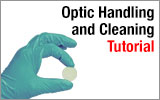
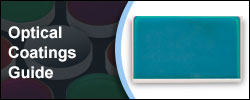
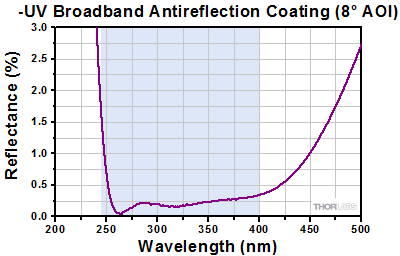
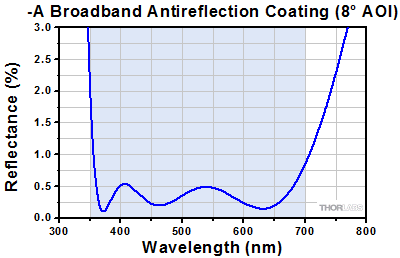
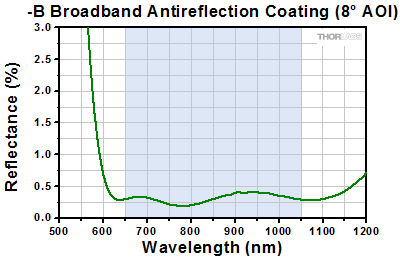
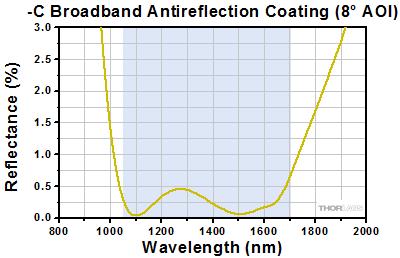
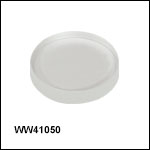
 Zoom
Zoom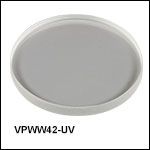
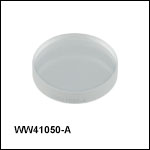
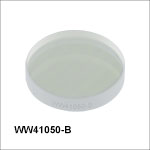
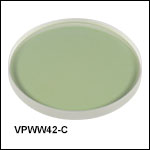
 UV Fused Silica Wedged Windows
UV Fused Silica Wedged Windows